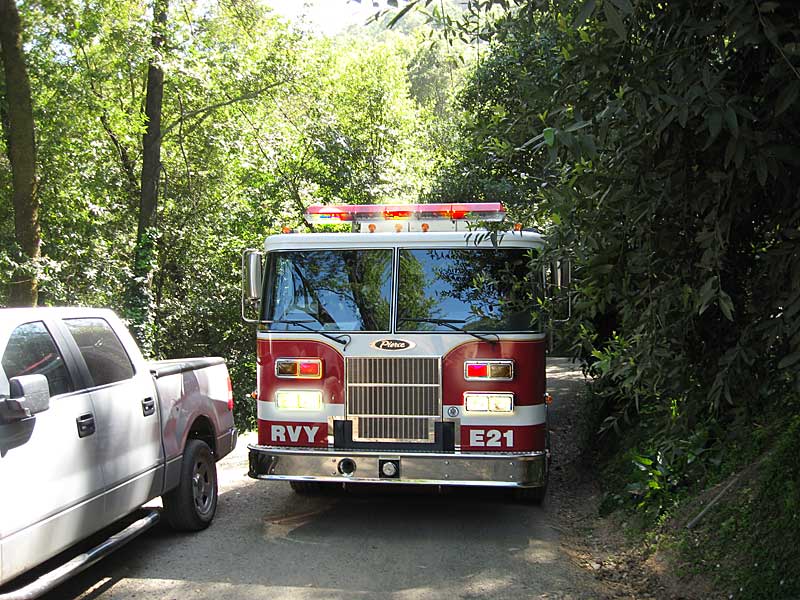Ross Valley Fire News
It's Fire Season: Do You Have Defensible Space?
Defensible space is essential to improve your home’s chance of surviving a wildfire. It’s the buffer you create between a building on your property and the grass, trees, shrubs, or any wildland area that surround it.
Defensible space will slow or stop the spread of wildfire and protect your home from catching fire – either from direct flame contact or radiant heat. Defensible space is also important to help protect firefighters when they are defending your home.
Your home may be the most valuable investment you ever make. If you live in a high-risk fire hazard area, protect against the chance of losing that investment by creating defensible space and using fire-resistant construction materials and techniques. Creating an area of defensible space does not mean you need a ring of bare dirt around your home. Through proper planning, you can have both a beautiful landscape and a fire safe home.
Defensible Space Zones

Three zones make up the required 100 feet of defensible space. The home ignition zone begins on the outside of your house and extends about 5-6 feet away. The home defense zone is within 30 feet of the house. The reduced fuel zone lies beyond the home defense zone, extending at least 100 feet from the house or to your property line. Greater defense zone widths may be necessary if your home is on a steep slope or in a windswept exposure. Specific recommendations for each zone are described below.
Home Ignition Zone
The home ignition Zone extends 0-10' from your house. It's the area closest to your house, including plants, decks, outdoor furniture, and the outside walls and coverings. This area is most vulnerable, and should be most aggressively maintained for fire resistance.
- Remove any combustible outdoor furniture.
- Replace jute or fiber door mats with fire resistant materials.
- Clean all fallen leaves and needles regularly. Repeat often during fire season.
- Remove ALL fire-prone plants, and choose only fire-resistant varieties. Irrigate regularly.
- Remove tree limbs that extend into this zone. Fire-prone trees should be aggressively pruned or ideally, removed.
- Provide adequate spacing between all plants.
- Do not store firewood, lumber, or combustibles here, even (especially) under decks or overhangs. Move stored combustibles inside, or at least 30' away from structures.
- Use only fire resistant mulches. 'Gorilla Hair" or similar shredded bark should be removed in this zone. Composted mulch and large bark and chips may be OK.
Home Defense Zone
This extends 30 feet* out from buildings, structures, decks, etc.
- Remove all dead plants, grass, and weeds (vegetation).
- Remove dead or dry leaves and pine needles from your yard, roof and rain gutters.
- Trim trees regularly to keep branches a minimum of 10 feet from other trees.
- Remove branches that hang over your roof and keep dead branches 10 feet away from your chimney.
- Relocate wood piles into Zone 2.
- Remove or prune flammable plants and shrubs near windows.
- Remove vegetation and items that could catch fire from around and under decks.
- Create additional separation between trees, shrubs and items that could catch fire, such as patio furniture, wood piles, swing sets, etc.
Reduced Fuel Zone
Extending from 30'-100' (or more, if required due to steep slopes, nearby vegetation conditions, and/or your local fire department), this zone should include at a minimum:
- Cut or mow annual grass down to a maximum height of 4 inches.
- Create horizontal spacing between shrubs and trees. (See diagram)
- Create vertical spacing between grass, shrubs and trees. (See diagram)
- Remove fallen leaves, needles, twigs, bark, cones, and small branches. However, they may be permitted to a depth of 3 inches if erosion control is an issue.
Defensible Space and Wildfire Resources:
FIRESafe MARIN
A local non-profit organization dedicated to reducing wildland fires. A good resource for finding Marin-specific conditions and recommendations.
Report a Fire Hazard Online
The Ross Valley Fire Department provides neighborhoods with a convenient way to report potentially hazardous conditions.
Ready for Wildfire
An excellent website created by CalFire. The website includes online guides and checklists to help you prepare your property, emergency supplies and family in the event of a wildland fire.
The Importance of Roadway Clearance
 Ross Valley Fire Department operates specialized fire apparatus that helps us navigate the narrow streets and hills of our community. Even with our state-of-the-art fire engines, we depend on roadways clear of obstructions and overgrown vegetation to access your neighborhood safely and quickly during emergencies. Cooperation and involvement from homeowners in each hillside neighborhood is critical to prevent obstructions, like illegally parked cars and overgrown vegetation, that ·impede our access and your safe escape in the event of a wildfire. Your survival during a fast spreading wildfire may depend on vegetation clearance work finished months earlier.
Ross Valley Fire Department operates specialized fire apparatus that helps us navigate the narrow streets and hills of our community. Even with our state-of-the-art fire engines, we depend on roadways clear of obstructions and overgrown vegetation to access your neighborhood safely and quickly during emergencies. Cooperation and involvement from homeowners in each hillside neighborhood is critical to prevent obstructions, like illegally parked cars and overgrown vegetation, that ·impede our access and your safe escape in the event of a wildfire. Your survival during a fast spreading wildfire may depend on vegetation clearance work finished months earlier.
